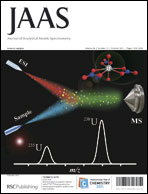Atomic spectrometry update-X-ray fluorescence spectrometry
Abstract
This review offers the reader a wealth of information published between April 2010 and March 2011 concerning analytical endeavours using the range of conventional and hyphenated XRF techniques that encourage the user to ensure the potential for high spectral sensitivity and, where appropriate, spatial resolution is achieved. The development of advanced micro-beam set ups and new X-ray optics driven by third generation

- This article is part of the themed collection: Atomic Spectrometry Updates

 Please wait while we load your content...
Please wait while we load your content...